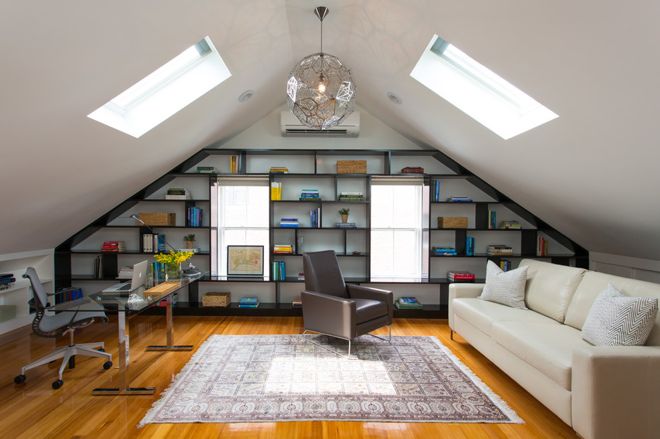Whether you purchased your home as a renovation project or to serve as your forever home, your house is an investment. And, as we start to consider opening back up after the pandemic, renovating your property for the rental return is becoming increasingly popular.
What used to be a way to take care of aging parents has turned into a potential investment opportunity. Converting an attic into a habitable space or building a granny flat are two home renovations that increase property value, rentable space, and overall investment. However, both projects involve a great deal of effort and time not to mention a hefty sum of money. So, is converting an attic or erecting a granny flat in the backyard worth the hassle? Will it really add value and make you money?
The Secondary Dwelling Unit is the official term used by architects and town planners but is synonymous with granny flats, in-law suites, backyard cottages, she sheds, etc. These units include a kitchen, bathroom, and living space as well as their own entrance. These units can take a few structural forms—the most common being:
• Stand-alone unit
• Garage conversion/over the garage build
• Attic or basement conversion
• Sectioning off part of the existing house
Depending on where you live, restrictions and regulations on these units will vary – each jurisdiction will likely have its own legislation and building codes outlining the rules for these units. Local and state development control plans will include standards on things like:
• parking
• maximum unit size
• lot coverage
• where it can be rented as a short-term rental
• whether owner occupancy is required
• specific regulations on details like ceiling heights, windows, and ventilation.
Granny flats would be considered a standalone unit and tend to be a fan-favorite among homeowners with excess space on their property. While you could fill this space with additional landscaping or play area for the kids, building a self-contained housing unit means extra livable space for children, aging parents, or potential rental income from tenants.
For those who don’t have extra land space, building up instead of out may be an option. Accessing your roof space can be a serious option – once again as long as the conversion meets planning regulations.
Making It Happen
Unlike building additions and completing renovations in the main space of a home, completing an attic conversion or granny flat is relatively unobtrusive because owners or existing tenants can remain in place while the units are being built. But just because you’ve decided to make the addition doesn’t mean you can just jump right in.
There’s a little red tape to clear before starting your build. The first thing you should do is check with the local council to be sure that building a granny flat or rental conversion will be permitted on your block or property. Councils in different regions have various requirements for residents wanting to build or renovate on their block of land. For example, in some areas of Queensland, it’s only permissible to rent out a granny flat if a family member will be living in it, and in some areas, housing density restrictions prohibit them entirely. Be sure to check with your local council before putting any down payments in place or signing any building contracts.
The next step is to consider the financial aspects of building your granny flat or attic conversion. You can get in touch with local builders and specialists to get an estimate for your project. Granny flats will be more costly because it’s a complete addition while attic conversions tend to be less expensive as they aren’t a freestanding buildings.
It’s important to ensure your finances are in place from day one if you plan to embark on any kind of renovation project. Either type of addition won’t cost as much as building a home, so you may be able to finance it by accessing your equity or by increasing or refinancing your current loan. Alternatively, you may be able to take out a construction loan. Contacting a banker or financial consultant will be beneficial if this is a new process to you — they’ll be able to determine how much you can afford to spend and help get your budget in order
The Pros And Cons Of Attic Conversions Vs. Granny Flats
There’s multiple reasons for constructing a granny flat or convert attic space. You could revamp the attic space so it becomes extra liveable square footage for your family (think a bedroom or an additional recreation room), or you could put up an ageing parent while still granting them access to the main house. Likewise, you could construct a granny flat without amenities like a kitchen, because the inhabitant may have access to the main house – or the space may be used by you.
However, one of the main reasons for constructing additional living space is to maximize the property’s value or to create a way to make passive income (renting it out to tenants).
The process for obtaining permits and making the decision to build granny flats or converting attic space is similar, but there are pros and cons of each to consider before committing to your project.
Cost and Requirements
Both granny flats and attic conversions require obtaining permits from your local council that adhere to council and building codes – think attributes like windows, headspace, minimum (or maximum) square footage, rooflines, etc. – and will vary depending on your region. Also, both projects will require a fairly large investment; however, attic conversions tend to be less expensive.
Privacy
If renting the space, a granny flat is ideal. Because it’s a free-standing structure, it will have its own entry access, kitchen, bathroom, and common spaces. However, you will have to determine and consider how much access to the main property the tenants will have. Do you want to be having a summer BBQ in the yard while the tenants are hanging by the pool? Probably not.
Unlike building your rental out, building up (attic conversion) is a desirable option but may come with less privacy. You could easily build out a self-sustaining unit (bathroom, kitchen, and living space) in an attic conversion, so you will retain some privacy from the main house. In most cases, attic spaces won’t have their own point of entrance – meaning your tenants will likely have to enter through the entrance of the main home. If the whole property is comprised on rentals, you may be able to work out a hallway or shared entrance situation, but if you and your family are living in the main house, you will want to consider this.
Parking
Something a lot of people don’t immediately consider when adding additional living space is parking for their new tenants. If you live on a corner lot and build a granny flat, not only will it have its own entrance but it’s likely the tenant’s parking spaces will be on another street than your own. However, if you are renting attic space, you should make sure you have taken parking into account. Lack of parking (or inclusion of it) will make an impact on potential rental value.

Is It Worth The Investment?
As mentioned earlier, the addition may or may not be worth the investment – depending on your situation and intention.
Adding either a granny flat or attic conversion space could add 20-30% to the value of your property, not to mention the potential income from rentals.
However, when it comes to resale, that’s when the value of the investment gets tricky. If you have added a granny flat or converted your attic to rentable space and make the decision to sell your property later, the value of that conversion will depend on the future buyer.
For example, if you have a buyer interested in your property who is also interested in renting out space for passive income, great! You’ve just found someone who will consider your investment worth it. On the other hand, if your new buyer is intending the property to be a single-family property, they may not be too keen on a second kitchen in the attic or the fact there’s an apartment in the backyard. Just because the investment was worth it to you, doesn’t mean they care to pay for it…because they wouldn’t have made the investment in the first place.
Conclusion
Adding a granny flat or converting the attic to a liveable space could potentially be a great investment for your property. It could increase the overall home value or be a way to generate additional income. However, there are things to consider before committing – things like cost, value of investment, and any rules and regulations that should be abided by. It’s smart to consult with building professionals, your local council, and potentially real estate agents to determine if the investment would in fact add value to your property and to make sure you are legally allowed to make the build.

About the author
Debra Beck-Mewing is the Editor of the Property Portfolio Magazine and CEO of The Property Frontline. She has more than 20 years’ experience in buying property Australia-wide and has extensive experience in helping buyers use a range of strategies including renovating, granny flats, sub-division and development. Debra is a skilled property strategist, and a master in identifying tailored opportunities, homes and sourcing properties that have multiple uses. She is a Qualified Property Investment Advisor, licensed real estate agent and also holds a Bachelor of Commerce and Master of Business. As a passionate advocate for increasing transparency in the property and wealth industries, Debra is a popular speaker on these topics. She is also an author, podcast host, and participates on numerous committees including the Property Owners’ Association.
Follow us on facebook.com/ThePropertyFrontline for regular updates, or book in for a strategy session to discuss your property questions.
Disclaimer – This information is of a general nature only and does not constitute professional advice. We strongly recommend you seek your own professional advice in relation to your particular circumstances.










